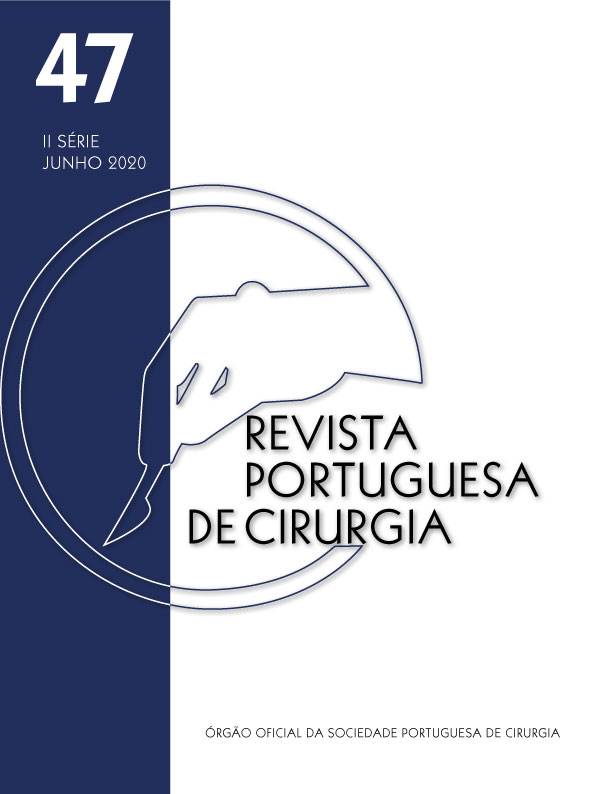SURGICAL TREATMENT OF CAROTID BODY TUMORS
DOI:
https://doi.org/10.34635/rpc.523Abstract
Os paragangliomas são tumores raros que se desenvolvem a partir do tecido paragangliónico. Na cabeça e pescoço, os seus principais locais de crescimento são o corpo carotídeo localizado na bifurcação da artéria carótida comum, o foramen jugulare, o ouvido médio e a porção cervical do nervo vago. Os autores relatam o caso clínico de uma doente portadora da mutação do gene SDHB com um tumor do corpo carotídeo do tipo II de Shamblin. O tratamento cirúrgico destes tumores é complexo e o seu seguimento deverá ser realizado em centros com experiência.
Em inglês:
Title: Surgical Treatment of Carotid Body Tumors
Abstract
Paragangliomas are rare tumors that develop from paraganglionic tissue. In head and neck, its main growth sites are the carotid body located at the bifurcation of the common carotid artery, the foramen jugulare, the middle ear and the cervical portion of the vagus nerve. The authors report the case of a holder of a SDHB gene mutation with a carotid body tumor Shamblin type II. Surgical treatment of these tumors is complex and its follow-up should be performed in centers with experience.
Keywords (MeSH Medical Subject Headings, Index Medicus)
Carotid body tumor (Tree number C04.557.465.625.650.700)
Paraganglioma (Tree number C04.557.465.625.650.700.705.220)
Head and neck neoplasms (Tree number C04.588.443)
Neuroendocrine Tumors (Tree number C04.557.465.625.650)
Carotid body (Tree number A08.675.650.915.500.600.150)
Downloads
References
Jatin P. Shah, Snehal G. Patel, Bhuvanesh Singh et al. Jatin Shah's Head and Neck Surgery and Oncology - Fourth Edition. Chapter 14: 570-613, 2012
Jae-Yol Lim et al. Surgical Treatment of Carotid Body Paragangliomas: Outcomes and Complications According to the Shamblin Classification. Clinical and Experimental Otorhinolaryngology, Vol. 3, Nº2: 91-95, June 2010
Theron T. Knight, Jr. et al. Current concepts for the surgical management of carotid body tumor. The American Journal of Surgery, 191:104-110, 2006
Naswa N. et al. Imaging carotid body chemodectomas with 68Ga-DOTA-NOC PET-CT. Br J Radiol – Aug 2012; 85 (1016); 1140
M. Antonello et al. Role of the Genetic Study in the Management of Carotid Body Tumor in Paraganglioma Syndrome. European Journal of Vascular & Endovascular Surgery, 2008-11-01, Volume 36, Issue 5, Pages 517-519
Koen E. A. Van der Bogt et al. Resection of Carotid Body Tumors – Results of an evolving surgical techique. Annals of Surgery, Volume 247, Number 5, May 2008
Downloads
Published
Issue
Section
License
Para permitir ao editor a disseminação do trabalho do(s) autor(es) na sua máxima extensão, o(s) autor(es) deverá(ão) assinar uma Declaração de Cedência dos Direitos de Propriedade (Copyright). O acordo de transferência, (Transfer Agreement), transfere a propriedade do artigo do(s) autor(es) para a Sociedade Portuguesa de Cirurgia.
Se o artigo contiver extractos (incluindo ilustrações) de, ou for baseado no todo ou em parte em outros trabalhos com copyright (incluindo, para evitar dúvidas, material de fontes online ou de intranet), o(s) autor(es) tem(êm) de obter, dos proprietários dos respectivos copyrights, autorização escrita para reprodução desses extractos do(s) artigo(s) em todos os territórios e edições e em todos os meios de expressão e línguas. Todas os formulários de autorização devem ser fornecidos aos editores quando da entrega do artigo.



